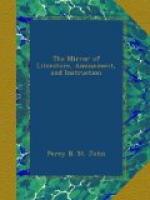“To return over the water, who would expect any thing poetical from East Smithfield? Yet there was born the most poetical even of poets, Spenser. Pope was born within the sound of Bowbell, in a street no less anti-poetical than Lombard-street. So was Gray, in Cornhill. So was Milton, in Bread-street, Cheapside. The presence of the same great poet and patriot has given happy memories to many parts of the metropolis. He lived in St. Bride’s Churchyard, Fleet-street; in Alders-gate-street, in Jewin-street, in Barbican, in Bartholomew-close; in Holborn, looking back to Lincoln’s Inn Fields; in Holborn, near Red-lion-square; in Scotland-yard; in a house looking to St. James’ Park, now belonging to an eminent writer on legislation, and lately occupied by a celebrated critic and metaphysician; and he died in Artillery-walk, Bunhill-fields; and was buried in St. Giles’, Cripplegate.
“Ben Jonson, who was born ‘in Hartshorne-lane, near Charing-cross,’ was at one time ‘master’ of a theatre in Barbican. He appears also to have visited a tavern called the Sun and Moon, in Aldersgate-street; and is known to have frequented with Beaumont and others, the famous one called the Mermaid, which was in Cornhill.
“The other celebrated resort of the great wits of that time was the Devil Tavern, in Fleet-street, close to Temple-bar. Ben Jonson lived also in Bartholomew-close, where Milton afterwards lived. It was in the passage from the cloisters of Christ’s Hospital into St. Bartholomew’s. Aubrey gives it as a common opinion, that at the time when Jonson’s father-in-law made him help him in his business of bricklayer, he worked with his own hands upon the Lincoln’s Inn garden wall, which looks upon Chancery-lane, and which seems old enough to have some of his illustrious brick and mortar still remaining.
“Under the cloisters in Christ’s Hospital (which stand in the heart of the city unknown to most persons, like a house kept invisible for young and learned eyes) lie buried a multitude of persons of all ranks; for it was once a monastery of Gray Friars. Among them is John of Bourbon, one of the prisoners taken at the battle of Agincourt. Here also lies Thomas Burdet, ancestor of the present Sir Francis, who was put to death in the reign of Edward IV., for wishing the horns of a favourite white stag, which the King had killed, in the body of the person who advised him to do it. And here too (a sufficing contrast) lies Isabella, wife of Edward II.
’She, wolf of France, with
unrelenting fangs,
Who tore the bowels of her mangled mate’
gray.
“Her ‘mate’s’ heart was buried with her, and placed upon her bosom! a thing that looks like the fantastic incoherence of a dream. It is well we did not know of her presence when at school; or after reading one of Shakspeare’s tragedies, we should have run twice as fast round the cloisters at night time, as we used. Camden, ’the nourrice of antiquitie,’ received part of his education in this school; and here also, not to mention a variety of others known in the literary world, were bred two of the most powerful and deep-spirited writers of the present day; whose visits to the cloisters we well remember.




